It’s hard to believe that we’ve passed the half way mark for our trip. Constant sunlight plays tricks with the mind. One day seems like two or three, and I can never keep track of the day of the week. Some days I feel the most energized at one in the morning, everything in my being protests wasting sunlight! If Papa Max didn’t set a bed time for us I might forget to sleep entirely.
Luckily we take full advantage of every waking hour. Groups are always headed out to collect water samples, measure trees, and feed the legion of mosquitoes. We must be a comical sight in our bug nets and Carhartts to the locals, who wear tank tops and scoff at “wimpy Americans.” We often marvel at how people could ever become so accustomed to the swarms of biting insects that they consciously choose to pass the day at the river in bikinis. The urge to swim, however, is less of a mystery. Until the last couple of days it’s felt like southern California around here.
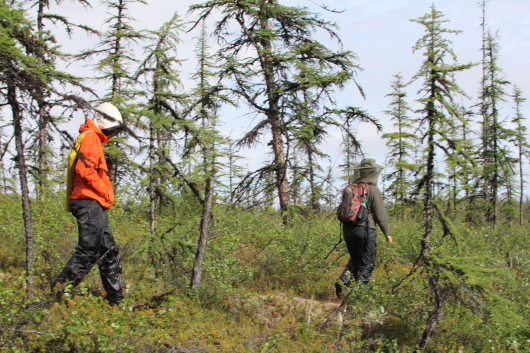
Allison and Sam weave their way through trees and shrubs to make their way to a terrestrial survey plot, which lies about a 15 minute walk from Orbita. © Becky Tachihara
Daily plunges into the chilly Panteleikha River keep moral high and postpone the inevitable shower. Living on the barge allows for easy swimming access, and for the observation of the tremendous variability in the water. The river at times is placid, at others turbulent. Some early mornings find it mirror-like and tranquil, with fog sitting low along the banks. It is strange to see a river with such a swift current appear so still. Some afternoons the waves are so rough they just about sweep disgruntled field assistants off the gangplank. Now and then the river is visibly divided down the middle, with the dirtier, colder water from the Kolyma River remaining separate from the Panteleikha because of the temperature difference. No matter the weather, the Panteleikha is home.
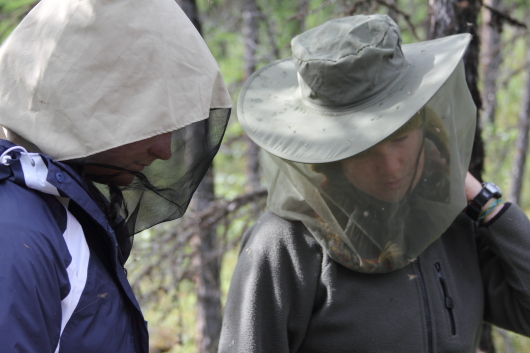
Dylan and Allison look down at the plot where they will be clipping vegetation samples for the terrestrial survey. © Becky Tachihara
I know I will miss the station when we leave. Siberia is beautiful. Most people picture a frozen, lifeless landscape when they think of Siberia, but this place has much more splendor than it gets credit for. Sometimes I get lost out there among the Larch trees and forget the rest of the world exists. I can understand why researchers are drawn here; not only does this ecosystem play an essential role in the global carbon cycle, but its vibrancy creates a surreal sense of serenity that impresses upon the mind the importance of preserving the arctic.
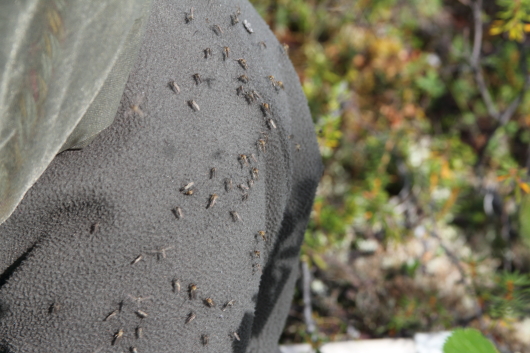
Mosquitoes swarm on Allison’s shoulder during a trip out into the field for the terrestrial survey. © Becky Tachihara
We all feel that urgency. The changes happening here are caused almost exclusively by the effects of carbon dioxide from outside sources. Anthropogenic activity in the arctic itself is limited. Unfortunately, there’s nothing we can do to stop the warming. All we can do is study the changes in an attempt to understand how they will affect the ecosystem in the future, and share what we learn with those not fortunate enough to visit the arctic themselves. That’s the primary goal of the Polaris Project.
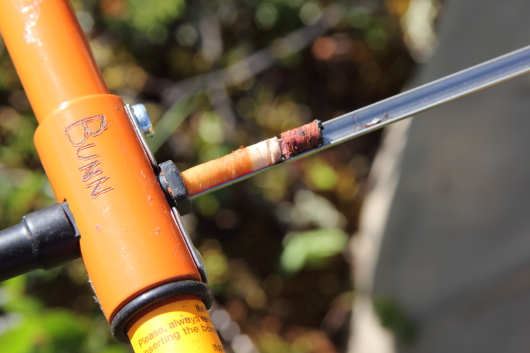
Andy pulls a tree core out of the corer. The cores will be put in paper straws to dry overnight before being mounted, sanded, counted and measured. © Becky Tachihara
I work with the terrestrial team of the Polaris Project. Our goal is to figure out how much carbon is stored above and below ground in this area, because it’s never been inventoried before. This means trying to tally up the total grams of carbon contained in trees, shrubs, mosses and soil within our .2 hectare plots, and then extrapolate our data to apply to the entire landscape using GIS and high resolution satellite images—quite a tall order.
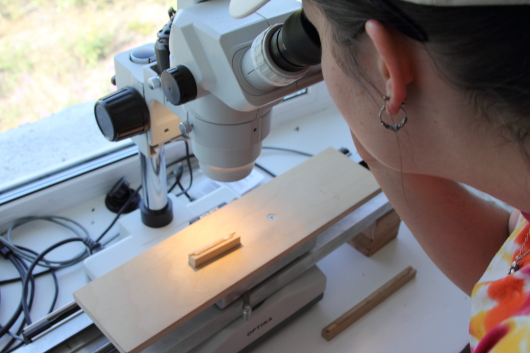
Allison looks at a tree core under a microscope in Orbita to see if it is sanded smoothly enough to being counting the rings. © Becky Tachihara
My project focuses on tree cores. We use an increment borer to core all of the trees on our plots, bring them back to the lab for processing, and measure the distance between each ring. So far we have cored around 200 trees and spent hours gluing, sanding and staring into a microscope. By comparing rings between trees within the same stand, we can see how their growth rates are correlated. This allows us to determine limiting factors for Larch trees in different environmental conditions. Our data is still coming together, but hopefully it will give us a better idea of how these forests are growing (and sequestering carbon) over time. The days remaining are dwindling and we are all scrambling to collect and analyze what we can. A week more isn’t long enough…



